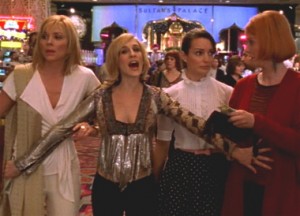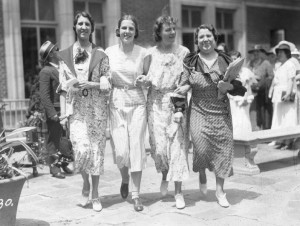I had a genuine Sex and the City weekend. I went to Atlantic City with my three best girlfriends (real-life translation: my husband’s five girl cousins). The initial plan was to take Richard Wright’s private jet, but due to unforeseen circumstances I had to catch the bus (real-life translation: the initial plan was to take the bus and so I caught the bus). We stayed, as Carrie calls it, at “the very understated Taj Mahal” (No translation needed. We really did stay at the Taj Mahal).
In the show, when Samantha first tells the girls that Richard is taking her on a trip to Atlantic City, Miranda responds with “What’d you do wrong?” That’s a pretty fair summation of the way most New Yorkers feel about AC. To survive a weekend there, it’s imperative that you either embrace the tackiness or else embrace the alcohol (thankfully, the latter helps you achieve the former).
Beyond all the tasteless glare though, beyond the sad old ladies at the slot machines and the even sadder young ladies dancing on tables, beyond the chintzy restaurants and the Jersey Shore jokes, there is something else to embrace about Atlantic City, something more elusive that hangs in the salted air and lingers, ghost-like, among the overblown casinos: a sense of history.
When I was very young, my parents took me to Atlantic City to visit my great-grandmother. If there was ever a real life Carrie Bradshaw, my great grandmother was it. Marian Elizabeth Gunther was the daughter of wealthy Canadian fur-trappers and so fashionable that she wore high-heeled slippers with her bathrobe. She married the prominent Dr. Edward Foy Uzzell in 1920 and they became the toast of Atlantic City society during its Golden Age. Those were the days of big bands at the Steel Pier and the expansion of the Treymore Hotel and the first Miss America pageant. By the time I was visiting her in the early 1980s, those days were gone, but Atlantic City was experiencing something of a comeback. The monster casinos had just started to open and money was flowing again and even a drop of the old glamour had returned, albeit filtered through the channels of ‘80s excess and Donald Trump.
Nowadays, however, its hard to find any tangible evidence of the good times. This past weekend, as I walked from the bus station to the Taj, from Michigan to Kentucky on Atlantic and then Pacific the rest of the way, I encountered the squalor. There is a frightening level of poverty and decay in Atlantic City; store windows are taped over, homeless populate every bench, and even in broad daylight there’s a sense of danger, something I never feel in New York. The casinos loom high behind this broken landscape, and they, too, look tattered and worn. Even the Borgata, with its gold mirrored exterior, looks like a piece of cheap costume jewelry.
But despite all this, Atlantic City has a certain dignity that comes from its infamous past, a past of broken rules and oddball characters and legendary parties and towering failures. It is the antithesis of the sanitized, middle-income American towns where strip-malls pattern every road and not one of them has a story to share. The indistinguishable towns across this country leave me feeling empty, but Atlantic City leaves me with the kind of ache you only get when something really worthwhile is gone.
As Carrie and Charlotte take a trolley ride down the boardwalk near the end of the episode, Carrie says, “Isn’t this amazing? It’s like a postcard from the ‘20s.” There are little pockets of the boardwalk that have been restored, painted with some charming color to make you forget about the problems that lie just a block away. But I don’t think Carrie was talking about the way Atlantic City looks, I think she was talking about the way Atlantic City feels. There is something in the air that, despite everything, still feels like a postcard from the ‘20s. It is a vibration that comes from the depths of the city itself that lets you know that something happened there once, something wonderful and something grand.
Every city rises and falls, that is to be expected. I only hope that one day, when New York’s time has come, whether that be in a thousand years or ten thousand years, people will know that something happened here too, even if it is just a feeling that drifts from the rubble and whispers, “Something happened here once, something wonderful and something grand.”
Emily Sproch is a writer and a “Sex and the City” tour guide. Each Friday, she chronicles the fine line between reality and fiction in her column “Almost Carrie.”














Lola
This blog is gloriously fantastic! I love that picture of the four women in 1934- Carrie- with the fashion forward colored shoes, Miranda with her more masculine look, Samantha clearly distracted by the packages at the beach, and Charlotte with itineraries prepared for all the girls.
I absolutely agree with you about that boardwalk feeling that brings you back to what it might have felt like in the 20s. I too am the granddaughter of a high heeled slipper wearer who was once told that Mr. Rodgers sang my grandmother lullabies on the beaches of Atlantic City. Thanks for reminding me of my heritage!
mom
What a vision ! I can smell the stale peanuts and see Mr. Peanut minus a few nuts.